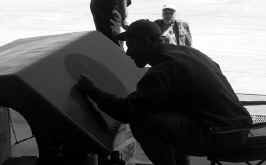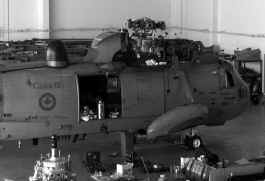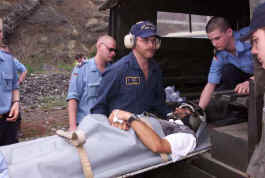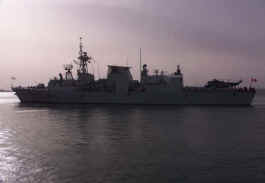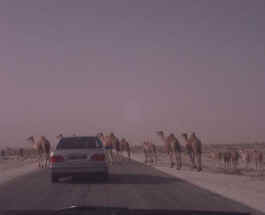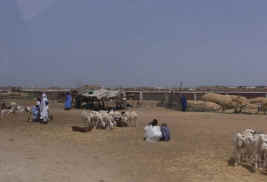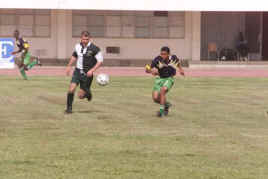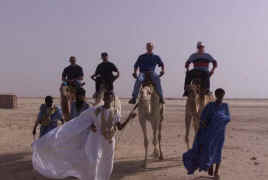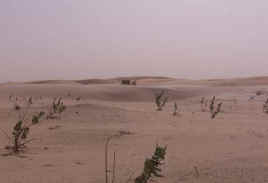|
|
|
| Lisbon was a very busy time for the groundcrew. During our five days there, they had to change the main transmission of the helicopter. (See SAR story, Apr 9) Lisbon is very old. Castles dot the city and surrounding area. Most of roads are made with small cube shaped stones, and are all very confusing! There's no such thing as a grid road system here. Some of us ate dinner at Castle de St Jorge, downtown, and had an exquisite meal. |
|
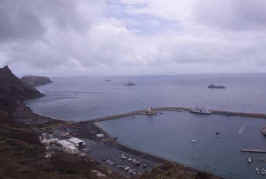 |
 |
| Very few people got to see the Madeira Islands up close. The Ship was anchored just off the coast of the second island for a few days. Still, it was breathtaking for all. The main island, only about 10 square miles, climbs steadily to over a mile in the air! It's hard to imagine how far below water the island keeps going before becoming sea floor. The fleet had a three day exercise there, where the bad guys (the other half of the fleet) had taken over the island, and our job was to evacuate all the locals (ship's personnel dressed in jeans) before anyone could get hurt. It was quite interesting. | |
|
|
|
|
|
|
| Mauritania was quite an experience. A real culture
shock. Can you imagine 800 000 people living in a town designed to
accommodate under 5000? Twenty to thirty years ago the entire western part
of the country experienced a massive drought. At that time, Nouakchott was
little more than a shipping town of a couple of thousand. The majority of
the population was scattered throughout the country in small villages and
nomadic tribes. The coastal region surrounding Nouakchott was lush and
green with vegetation. I was told the whole area around Nouakchott was a
huge forest. The drought, however, killed most of the vegetation along the
coast. Since then, the Sahara has pushed its way right to the coastline,
and the city is trying to reclaim the land the desert has taken by growing
a greenbelt around the city. The drought lasted so long, people began to
migrate to the larger towns capable of supporting a small population with
sufficient food and water. That's when Nouakchott began to grow. The
city is literally being swallowed by the Sahara. The sand here makes it as
difficult to get around as snow does at home. Sand drifts sometimes make
roads impassable as a snow drift.
Twenty years later, little more has been done to support the massive growth of the city. There is little sewage treatment, plumbing, or electricity, and very few phones. Nevertheless I found the people to be quite content and very friendly, although their culture is one you have to grow accustomed to. If you gave someone a simple gift like a Canada pin or a sticker, in less than 5 seconds you would have thirty men, boys, and children hounding you for the same. We were the main attraction for the city. Wherever you walked in the markets there was always a group of men and children following you. Kids would be walking the streets with tin cans plastered with Fredericton Stickers, begging for money, begging for more stickers. The merchants at the markets are very aggressive sales people. The trade/economic system seemed to be based on bartering and price negotiation. Actually, there were no prices. They charge you what they feel you're willing to spend, and in our case (i.e. the white "American") they start at about 50 times what it's worth. Not a bad system, really. You can normally work your way down from $100US to $20US. And so you, the "American", feel you got a good deal. The merchant knows he got a good deal, because in Mauritania $100US can feed a man for a year. In most cases, both of you leave the bargaining table content. The jewellery we saw for sale was extraordinary. All of it is hand made
in the markets where it is sold. Silver was the precious metal of choice,
although you could find many things detailed in gold, copper, bronze,
bone, wood (teak and ebony being the most popular), and even ivory. I went
in behind one of the booths to watch some men melt, carve, and etch a
small block of silver into assorted delicate pieces. There were about
seven men between ages 25 and 50, all crouched in the dirt, leaning
against the walls of the shack. Each had a torch and a small poker,
etching, in minute detail, patterns onto hand made silver bracelets;
weaving and braiding fine silver threads into rings and necklaces. Imagine
a hand made silver chain with links only half a millimeter long. When I
walked into the shack you could tell they were a people proud of their
work. Well, obviously word spread quickly that there was a Canadian ship in Mauritania, and we met several Canadians who came to visit us: United Nations Humanitarian workers, students on work scholarships, volunteers.. you name it, even an American Green Beret. We (the Wardroom) met a Canadian engineer, Sarah Mee, who's been here for about 9 months working for the UN under a Canadian work scholarship. They were all very pleased to sit with us and experience a piece of Canada so far away from home. Our visit to Mauritania really has helped me appreciate what we as a country and as a people have at home, and what we take for granted. I'm glad I was given the opportunity to visit here. |
|

